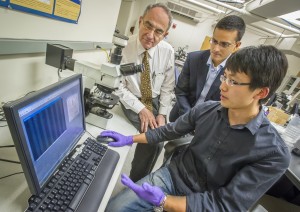From solar cells to optoelectronic sensors to lasers and imaging devices, many of today’s semiconductor technologies hinge upon the absorption of light. Absorption is especially critical for nano-sized structures at the interface between two energy barriers called quantum wells, in which the movement of charge carriers is confined to two-dimensions. Now, for the first time, a simple law of light absorption for 2D semiconductors has been demonstrated.
 (From left) Eli Yablonovitch, Ali Javey and Hui Fang discovered a simple law of light absorption for 2D semiconductors that should open doors to exotic new optoelectronic and photonic technologies. (Photo by Roy Kaltschmidt)
(From left) Eli Yablonovitch, Ali Javey and Hui Fang discovered a simple law of light absorption for 2D semiconductors that should open doors to exotic new optoelectronic and photonic technologies. (Photo by Roy Kaltschmidt)
Working with ultrathin membranes of the semiconductor indium arsenide, a team of researchers with the U.S. Department of Energy (DOE)’s Lawrence Berkeley National Laboratory (Berkeley Lab) has discovered a quantum unit of photon absorption, which they have dubbed “AQ,” that should be general to all 2D semiconductors, including compound semiconductors of the III-V family that are favored for solar films and optoelectronic devices. This discovery not only provides new insight into the optical properties of 2D semiconductors and quantum wells, it should also open doors to exotic new optoelectronic and photonic technologies.
“We used free-standing indium arsenide membranes down to three nanometers in thickness as a model material system to accurately probe the absorption properties of 2D semiconductors as a function of membrane thickness and electron band structure,” says Ali Javey, a faculty scientist in Berkeley Lab’s Materials Sciences Division and a professor of electrical engineering and computer science at the University of California (UC) Berkeley. “We discovered that the magnitude of step-wise absorptance in these materials is independent of thickness and band structure details.”
Javey is one of two corresponding authors of a paper describing this research in the Proceedings of the National Academy of Sciences (PNAS). The paper is titled “Quantum of optical absorption in two-dimensional semiconductors.” Eli Yablonovitch, an electrical engineer who also holds joint appointments with Berkeley Lab and UC Berkeley, is the other corresponding author. Co-authors are Hui Fang, Hans Bechtel, Elena Plis, Michael Martin and Sanjay Krishna.
Previous work has shown that graphene, a two-dimensional sheet of carbon, has a universal value of light absorption. Javey, Yablonovitch and their colleagues have now found that a similar generalized law applies to all 2D semiconductors. This discovery was made possible by a unique process that Javey and his research group developed in which thin films of indium arsenide are transferred onto an optically transparent substrate, in this case calcium fluoride.
“This provided us with ultrathin membranes of indium arsenide, only a few unit cells in thickness, that absorb light on a substrate that absorbed no light,” Javey says. “We were then able to investigate the optical absorption properties of membranes that ranged in thickness from three to 19 nanometers as a function of band structure and thickness.”
Using the Fourier transform infrared spectroscopy (FTIR) capabilities of Beamline 1.4.3 at Berkeley Lab’s Advanced Light Source, a DOE national user facility, Javey, Yablonovitch and their co-authors measured the magnitude of light absorptance in the transition from one electronic band to the next at room temperature. They observed a discrete stepwise increase at each transition from indium arsenide membranes with an AQ value of approximately 1.7-percent per step.
“This absorption law appears to be universal for all 2D semiconductor systems,” says Yablonovitch. “Our results add to the basic understanding of electron–photon interactions under strong quantum confinement and provide a unique insight toward the use of 2D semiconductors for novel photonic and optoelectronic applications.”
This research was supported by DOE’s Office of Science and the National Science Foundation.